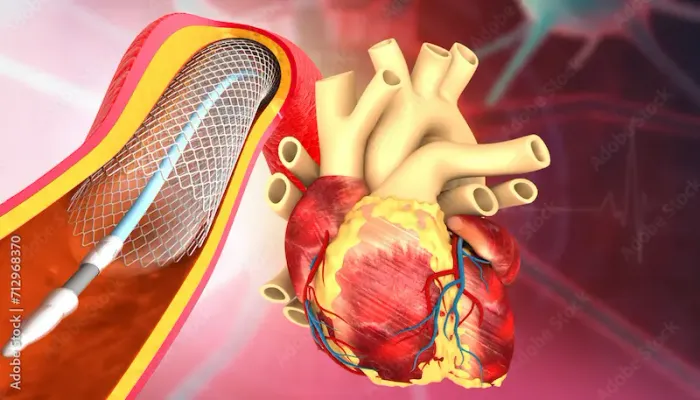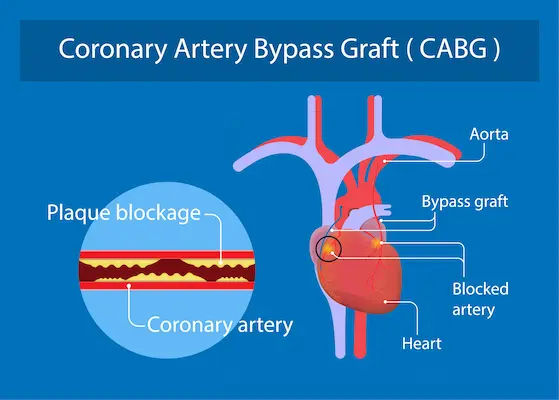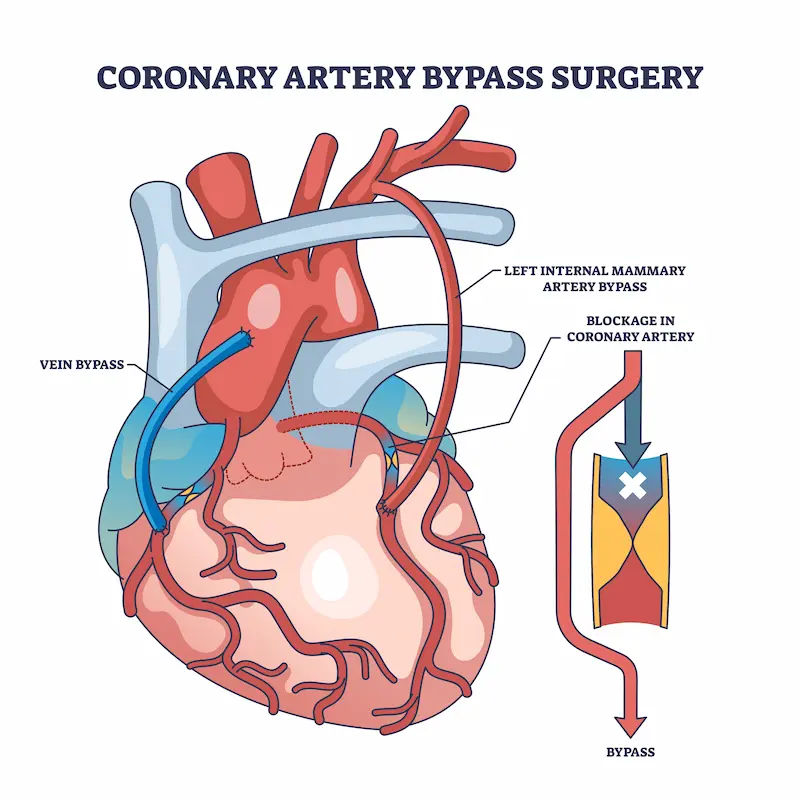Stents vs. Bypass Surgery A Guide to Heart Procedures
Compare stents and bypass surgery for coronary artery disease, including procedures, recovery, risks, and long-term outcomes, to make informed decisions for your heart health.

Written by Dr. Siri Nallapu
Reviewed by Dr. Shaik Abdul Kalam MD (Physician)
Last updated on 8th Oct, 2025

Introduction
When faced with blocked coronary arteries, the path to better heart health often leads to a critical decision: stents or bypass surgery? This choice is not one-size-fits-all; it's a complex medical decision tailored to your unique anatomy and overall health. Both procedures are highly effective at restoring blood flow to the heart muscle, relieving symptoms like chest pain, and reducing the risk of a heart attack. However, they differ significantly in their approach, invasiveness, and long-term implications. This comprehensive guide will demystify stents and bypass surgeries, providing a clear, head-to-head comparison. We'll break down how each procedure works, who it's best for, what recovery looks like, and the key factors you and your doctor will consider to determine the right option for you. Our goal is to empower you with knowledge, so you can actively participate in your heart care journey.
Understanding the Root Cause: Coronary Artery Disease (CAD)
Before diving into the procedures, it's crucial to understand the problem they solve: coronary artery disease (CAD). CAD is the most common type of heart disease, occurring when the major blood vessels (coronary arteries) that supply your heart with blood, oxygen, and nutrients become damaged or diseased. This damage is almost always due to atherosclerosis.
What is Atherosclerosis?
Atherosclerosis is the buildup of plaque—a combination of cholesterol, fatty substances, cellular waste products, calcium, and fibrin (a clotting material in the blood)—inside the artery walls. Imagine your arteries as smooth, flexible pipes. Over time, due to factors like high blood pressure, smoking, high cholesterol, and diabetes, these pipes can become damaged. Plaque starts to accumulate at the site of this damage, much like rust inside a pipe. This buildup narrows the arteries, restricting the flow of oxygen-rich blood to the heart muscle.
How Blocked Arteries Lead to Heart Problems
When the heart muscle doesn't get enough blood, it causes chest pain or discomfort known as angina. This is often a warning sign. If a plaque ruptures, a blood clot can form on its surface, completely blocking the artery. This sudden blockage cuts off blood flow to a part of the heart, leading to a heart attack (myocardial infarction), which can cause permanent damage to the heart muscle. Both stents and bypass surgeries are designed to prevent this by restoring adequate blood flow. If you experience persistent chest pain, shortness of breath, or other symptoms of heart trouble, it's crucial to consult a doctor. You can book a quick online consultation with a cardiologist on Apollo24|7 for an initial assessment.
Consult a Cardiac Surgeon for the best advice
What Are Stents? The Minimally Invasive Approach
A stent is a small, mesh-like tube used to prop open a narrowed artery. The procedure to place a stent is called percutaneous coronary intervention (PCI), commonly known as angioplasty.
The Procedure: Percutaneous Coronary Intervention (PCI) Explained
PCI is a minimally invasive procedure. It doesn't require large incisions or opening the chest. Instead, a cardiologist inserts a thin, flexible catheter into an artery, usually in the wrist or groin. This catheter is carefully guided up to the blocked coronary artery. A tiny balloon at the tip of the catheter is inflated at the site of the blockage, compressing the plaque against the artery wall and widening the artery. The stent, which is mounted on the balloon, expands with the balloon and locks into place. The balloon is then deflated and removed, leaving the stent behind to act as a scaffold, keeping the artery open.
Types of Stents: Bare-Metal vs. Drug-Eluting
There are two primary types of stents:
1. Bare-Metal Stents (BMS): These are simple mesh tubes. They are effective but have a higher risk of the artery re-narrowing (a process called restenosis) as scar tissue can grow through the mesh.
2. Drug-Eluting Stents (DES): These are coated with medication that is slowly released to prevent restenosis. DES are now the most commonly used type of stent because they significantly reduce the need for repeat procedures.
Ideal Candidates for Stent Placement
Stents are often the preferred option for patients with fewer blockages that are located in accessible places. They are particularly suitable for treating sudden heart attacks, as they can be deployed quickly to open the blocked artery. They are also ideal for patients who may not be strong enough to withstand the physical stress of major surgery.
What is Bypass Surgery? The Comprehensive Replumbing
Coronary artery bypass grafting (CABG), or bypass surgery, is a major open-heart surgery. Instead of clearing the blocked artery, it creates a new route for blood to flow around the blockage.
The Procedure: Coronary Artery Bypass Grafting (CABG) Demystified
During CABG, a cardiac surgeon makes an incision down the center of the chest to access the heart. The heart is typically stopped temporarily, and a heart-lung machine takes over the function of circulating blood. The surgeon then takes a healthy blood vessel—a graft—from another part of the body (like the chest, leg, or arm) and attaches one end to the aorta (the main artery from the heart) and the other end to the coronary artery below the site of the blockage. This creates a "bypass" for blood to flow freely. A patient may receive single, double, triple, or more bypasses depending on the number of blocked arteries.
Where Do the Grafts Come From?
The most common grafts are:
1. Internal Mammary Artery (IMA): Taken from inside the chest wall. This is the most durable and preferred graft.
2. Saphenous Vein: Taken from the leg.
3. Radial Artery: Taken from the forearm.
Ideal Candidates for Bypass Surgery
Bypass surgery is typically recommended for more complex cases of CAD. This includes patients with:
1. Blockage of the left main coronary artery.
2. Multiple severely blocked arteries, especially those with diabetes.
3. Weakened heart muscle (low ejection fraction).
4. Blockages that are not suitable for stenting due to their location or complexity.
Stents vs. Bypass Surgery: A Head-to-Head Comparison
This is the core of the decision-making process. Let's compare the two across key parameters.
Comparing the Procedures: Invasiveness and Recovery Time
This is the most stark difference.
• Stents (PCI): Minimally invasive. Performed under local anaesthesia. Hospital stay is typically 1-2 days. Most patients can return to normal activities within a week.
• Bypass (CABG): Major surgery. Performed under general anaesthesia. Hospital stay is usually 5-7 days. Full recovery, including sternum healing, takes 2-3 months.
Comparing Long-Term Outcomes and Durability
While recovery is faster with stents, the long-term picture is more nuanced.
• Stents: Effective but carry a risk of the artery re-narrowing inside the stent (in-stent restenosis) or forming blood clots (stent thrombosis). Patients may require repeat procedures years later.
• Bypass: Especially when using arterial grafts like the IMA, bypass surgery is considered more durable for complex multi-vessel disease. Studies like the SYNTAX trial have shown that for patients with extensive three-vessel disease or left main blockages, CABG often provides better long-term survival and freedom from repeat procedures compared to stents.
Risks and Potential Complications of Each
Both procedures carry risks, though the profile differs.
• Stent Risks: Bleeding at the catheter site, artery damage, allergic reaction to the stent or dye, restenosis, and blood clots.
• Bypass Risks: These are more extensive due to the nature of open-heart surgery and include infection, bleeding, stroke, heart attack, irregular heartbeats, and memory loss or "pump head" (often temporary).
How is the Decision Made? It's Not a Simple Choice
The choice between a stent and a bypass is not made lightly. It's a collaborative decision based on a thorough evaluation.
The Role of the "Heart Team"
Modern cardiology emphasises a "Heart Team" approach. This team typically includes an interventional cardiologist (who places stents) and a cardiac surgeon (who performs bypasses). They review your specific case—your angiogram results, overall health, age, and preferences—to recommend the best evidence-based option for you.
Key Factors That Influence the Decision
The Number and Location of Blockages
This is the primary factor. A single, straightforward blockage is ideal for a stent. For blockages in the left main artery or all three major arteries, bypass is often the preferred choice for long-term durability.
Your Overall Health and Age
A patient's ability to withstand major surgery is critical. Older patients or those with other serious health conditions (like lung or kidney disease) may be better suited for the less invasive stent procedure.
The Presence of Other Conditions like Diabetes
Patients with diabetes often have more widespread and complex artery disease. Major studies have consistently shown that diabetics with multi-vessel disease tend to have better long-term outcomes with bypass surgery compared to stenting.
Life After the Procedure: Recovery and Long-Term Management
Whether you receive a stent or a bypass, the procedure is a treatment, not a cure for coronary artery disease. Lifelong management is essential.
The Critical Role of Cardiac Rehabilitation
Cardiac rehab is a supervised program of exercise, education, and counselling. It is strongly recommended for all patients after either procedure. It helps you regain strength, reduce risk factors, and improve your overall cardiovascular health.
Medications You Will Likely Need
You will likely be prescribed several medications, including:
1. Antiplatelets (e.g., Aspirin, Clopidogrel): To prevent blood clots from forming in stents or grafts.
2. Statins: To lower cholesterol and stabilise plaque.
3. Beta-blockers: To lower blood pressure and heart rate.
4. ACE Inhibitors: To help the heart function better.
Essential Lifestyle Changes for a Healthy Heart
This is non-negotiable. Adopting a heart-healthy lifestyle is the key to protecting your investment. This includes quitting smoking, eating a balanced diet (like the Mediterranean diet), exercising regularly, and managing stress. To support your journey, Apollo24|7 offers convenient home collection for essential monitoring tests like cholesterol panels and HbA1c, making it easier to track your progress.
Conclusion
Choosing between stents and bypass surgery is one of the most significant decisions in cardiac care. There is no universally "better" option; the right choice is the one that is best for your specific heart anatomy and overall health profile. Stents offer a remarkable, minimally invasive solution for many, providing rapid relief and a quick return to daily life. Bypass surgery, while more demanding, remains the gold standard for complex coronary disease, offering proven long-term durability and survival benefits. The most important step is to have an open, informed discussion with your cardiologist and cardiac surgeon. Ask questions, understand the risks and benefits of each approach in the context of your situation, and commit to the essential lifestyle changes and medications required after either procedure. Your heart health is a lifelong journey, and this decision is a powerful step forward on that path.
Consult a Cardiac Surgeon for the best advice
Consult a Cardiac Surgeon for the best advice

Dr. Syed Akram Ali
Cardiologist
14 Years • MBBS DCH DNB(PED) DNB(CARD) CONSULTANT INTERVENTOINAL CARDIOLOGIST, EUROPEAN SOCIETY OF CARDIOLOGY CERTIFIED HEART FAILURE SPECIALIST
Hyderabad
AYMAN POLYCLINIC, Hyderabad

Dr. Sumanjita Bora
Cardiologist
9 Years • MBBS, PGDCC
Bengaluru
Apollo Clinic, Sarjapur Road, Bengaluru

Dr. Zulkarnain
General Physician
2 Years • MBBS, PGDM, FFM
Bengaluru
PRESTIGE SHANTHINIKETAN - SOCIETY CLINIC, Bengaluru

Dr. Anand Ravi
General Physician
2 Years • MBBS
Bengaluru
PRESTIGE SHANTHINIKETAN - SOCIETY CLINIC, Bengaluru
Dr. Mahendranath Subramani Prasad
Cardiologist
16 Years • MBBS,MS ,DNB, M.Ch. Cardiovascular and Thoracic Surgery(Cardiology)
Bengaluru
Apollo Clinic, Sarjapur Road, Bengaluru
Consult a Cardiac Surgeon for the best advice

Dr. Syed Akram Ali
Cardiologist
14 Years • MBBS DCH DNB(PED) DNB(CARD) CONSULTANT INTERVENTOINAL CARDIOLOGIST, EUROPEAN SOCIETY OF CARDIOLOGY CERTIFIED HEART FAILURE SPECIALIST
Hyderabad
AYMAN POLYCLINIC, Hyderabad

Dr. Sumanjita Bora
Cardiologist
9 Years • MBBS, PGDCC
Bengaluru
Apollo Clinic, Sarjapur Road, Bengaluru

Dr. Zulkarnain
General Physician
2 Years • MBBS, PGDM, FFM
Bengaluru
PRESTIGE SHANTHINIKETAN - SOCIETY CLINIC, Bengaluru

Dr. Anand Ravi
General Physician
2 Years • MBBS
Bengaluru
PRESTIGE SHANTHINIKETAN - SOCIETY CLINIC, Bengaluru
Dr. Mahendranath Subramani Prasad
Cardiologist
16 Years • MBBS,MS ,DNB, M.Ch. Cardiovascular and Thoracic Surgery(Cardiology)
Bengaluru
Apollo Clinic, Sarjapur Road, Bengaluru
More articles from Coronary artery disease
Frequently Asked Questions
1. What is the life expectancy after a bypass surgery?
Life expectancy after CABG is generally very good and often matches that of the general population when patients adhere to medications and lifestyle changes. Studies show that over 90% of patients are alive after one year, and about 60-70% after 10 years. The durability of the grafts, particularly the internal mammary artery, contributes to excellent long-term outcomes.
2. Can a blocked artery be cleared without a stent or bypass?
In the early stages of CAD, lifestyle changes and medications can help slow the progression of plaque. However, once an artery is significantly blocked, medications cannot remove the plaque. Procedures like stenting or bypass are necessary to physically restore blood flow. There is no proven natural remedy to 'clear' severe blockages.
3. What is the main difference between a heart attack and cardiac arrest?
A heart attack is a circulatory problem. It occurs when a blocked artery stops blood flow to the heart muscle. Cardiac arrest is an electrical problem. It happens when the heart's electrical system malfunctions, causing the heart to stop beating effectively. A heart attack can trigger cardiac arrest.
4. How long does a stent last?
A stent is a permanent implant. The question is often about its long-term patency (staying open). Drug-eluting stents are designed to be permanent solutions. However, the disease can progress, and new blockages can form in other parts of the artery, sometimes necessitating additional treatment.
5. Is bypass surgery more successful than stents?
'Success' depends on the patient's specific condition. For less complex, single-vessel disease, stents are highly successful. For extensive multi-vessel disease, especially in diabetics, bypass surgery has been shown in large clinical trials to provide better long-term survival and reduce the need for repeat procedures, making it the more successful strategy in those scenarios.
 Purpose, Procedure, and Results.webp)



